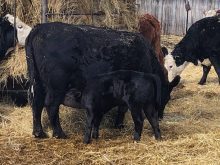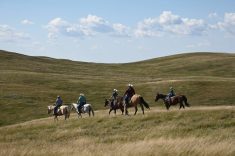With food safety always a top media issue, there is increased awareness among consumers of foodborne zoonotic diseases such as Salmonella, Campylobacter, Listeria and most recently E. coli.
Every time there is a meat recall or an increase in disease incidence from other sources such as water or contaminated vegetables, it becomes a big media event. With this exposure, consumer confidence in the safety of our food supply decreases and the overall costs to our medical system increases substantially.
The recent XL Foods plant closure at Brooks, Alta. is testament to how the whole cattle industry can be held hostage by foodborne pathogens. They are hard to detect and almost impossible to totally eliminate. Even if everyone appears to be doing things right along the food chain, disease can still raise their ugly heads from time to time.
Read Also

Harvest wraps up and fall work begins
At the Eppich famly ranch in western Saskatchewan, the fall harvest was successful with few breakdowns, cows and calves have been sorted and a new tractor has arrived
The psychological, emotional and mental strain on affected families also cannot be overstated.
There must be a collective effort to prevent disease contamination down the entire food production and preparation chain. We need to address the problem where it originates and not always make the packing plant the scapegoat. With the release of an E. coli 0157H7 vaccine in Canada several years ago and other preventative measures this disease can be greatly controlled in the future.
Canadian solution
With the made-in-Canada vaccine “Econiche,” Canada became the first country in the world to have preventative treatment available. Statistics tell us there are upwards of 100,000 human cases of E. coli poisoning in North America yearly. Of these an average of five per cent get the hemolytic urologic syndrome, which can cause kidney failure or death. This primarily affects children. The vaccine would be the most effective way to reduce the number of organisms present in cattle, the primary shedder of the bacteria. Use of the vaccine would greatly reduce the unrecognizable bacterial burden being presented to our packing plants.
We know almost half of the human cases of E. coli infection come from food sources other than meat. If we further check the original source of contamination, cattle are singled out as the primary reservoir. Whether it is E. coli getting into the water sources from manure runoff, vegetables being contaminated through irrigation water or people exposed to cattle at fairs, shows or other events, minimizing the level at the source (cattle) will minimize these other routes of human infection as well.
Feedlot level
Prevalence of E. coli 0157:H7 at the feedlot varies greatly, with a definite increased risk in summer and fall. The disease rates also corresponds to the greatest usage of ground beef and the North American barbecue season. Vaccination would greatly complement other procedures down the food chain. The reduction of shedding by 60 per cent has a dramatic effect on disease control. High-level shedders in the feedlot are only three per cent of the population, yet how do we identify them? They are as healthy as the rest of the cattle. Super shedders, which have a million times the shedding magnitude and reprresent the greatest risk of contamination and prevalence of E. coli in the cattle population, have been identified. The use of chlorinated water, bacteriophages or probiotics also complement control at the feedlot, but vaccination provides the greatest reduction in fecal shedding. With the vaccine, you are hitting the problem at its source before the bacteria numbers get too high.
Other management options
If we examine other potential management changes at the feedlot, several points come to mind. A lot of potential bacterial contamination at the feedlot comes in the form of tag attached to the hide, so any measure to minimize tag is a benefit. Woodchips, sawdust and straw are all used as bedding material, mainly because of availability. In our area woodchips seem to result in the lowest amount of tag, but the benefits of different bedding materials is an area that must be studied further.
Larger feedlots have a greater concentration of cattle and often more limited manpower resources for bedding on a per-head basis. Climatic conditions vary greatly year-to-year making disease control difficult. One research group developed an innovative and simple test for the presence of E. coli 0157:H7 in pens of cattle. It involves short sections of rope hung on the feed bunk. Curious cattle lick the ropes which are then collected for culture. If E. coli 0157:H7 is in the pen, it will show up on the ropes.
Further downstream through the packing plants towards final retail and consumer levels several other preventative procedures work synergistically with vaccination. Packing plants already spend more than $5 per animal on procedures like steam-treating carcasses and cleaning based on a strict HACCP plan. These measures help prevent contamination with E. coli as well as other food-source zoonotic diseases. The meat industry is also looking at use of irradiation for disease control. It is an expensive treatment and really only doable at very large plants. But, it may make sense in helping to further insure all meat is safe when leaving the plant.
Consumer level
The final responsibility for safe food lies absolutely directly with the consumer. It is the responsibility of consumers to properly and fully cook meat regardless of type or source. Also washing the vegetables thoroughly and keeping food preparation area clean are all part of good kitchen practice. Proper food handling should be the last thing you do before putting food in your mouth.
What the future holds for E. coli vaccination is an evolving process. Will cattle and other animal exhibits or shows insist on vaccination? Will monitoring identify-specific feedlots with higher levels that will be forced to implement vaccination? In the barbecue season when the incidence of bacteria infection rises, will a premium be paid for cattle identified through our national identification program as “Econiche” vaccinated? Will cattle with lots of tag need to be vaccinated? Will the government help cover the cost of the vaccination out of the human health care budget as a way to greatly reduce overall health care costs?
It is hard to put a value on human life or estimate the potential impact of class action lawsuits, but legal proceedings and judgments have potential to be very costly and can paralyze our industry. Vaccination together with the other preventative steps mentioned will hopefully keep this dreaded disease to a minimum and keep consumer confidence in our food source as high as possible.
Perhaps the Canadian Food Inspection Agency should take the lead in helping the whole beef supply chain sort out the solutions to keeping beef safe and consumer confidence high. All the potential “helps” represent a great deal of effort, time, and money to control a diseases, which really have no ill effects on the cattle themselves. And that creates a dilemma.
For further information check out two very good websites: www.fightecoli.com and www.econichevaccine.com †














